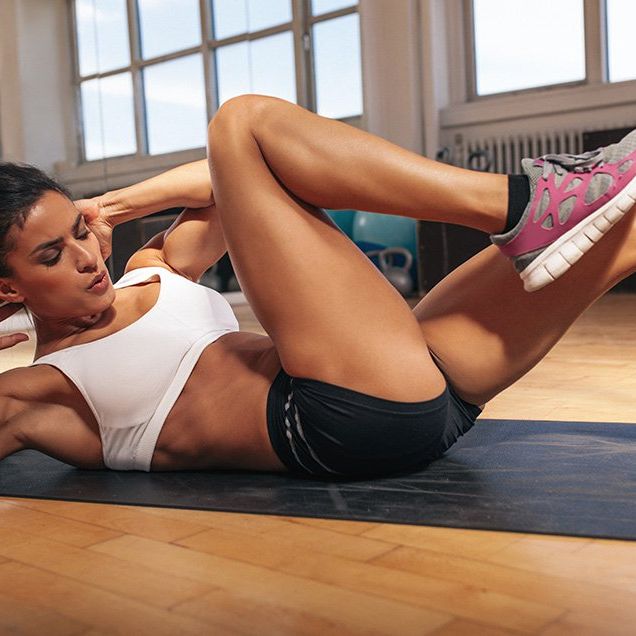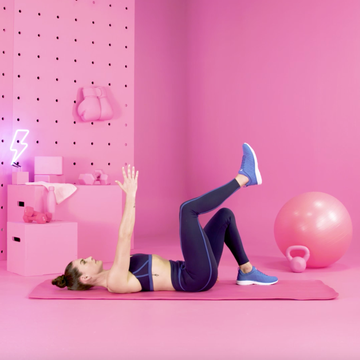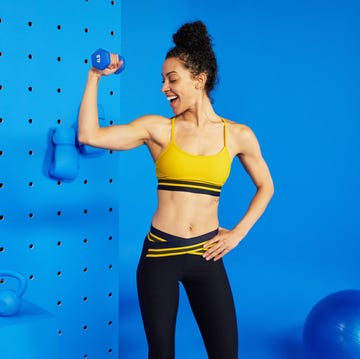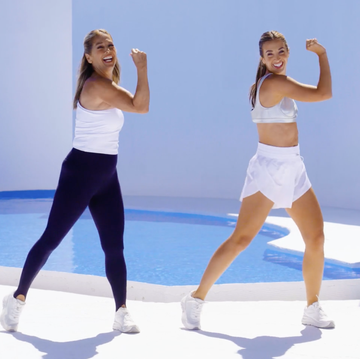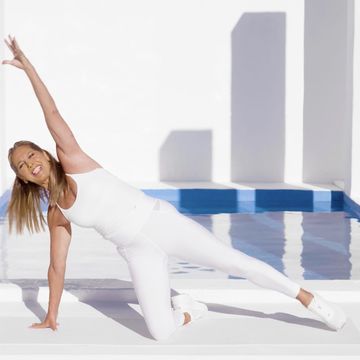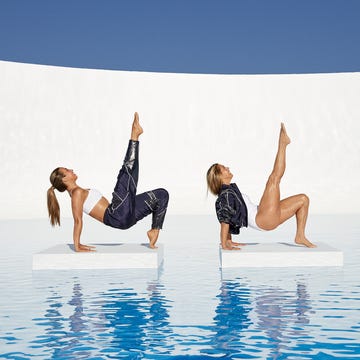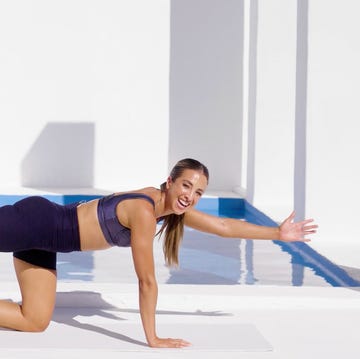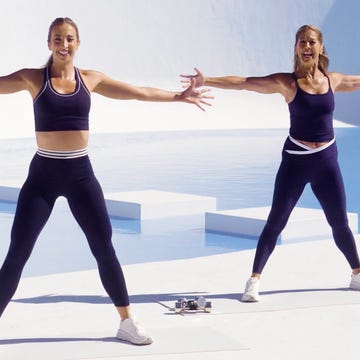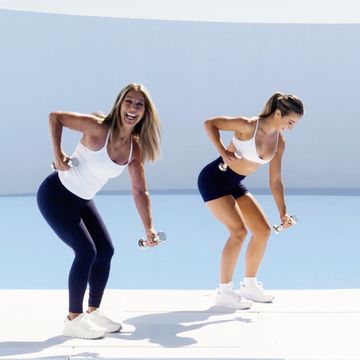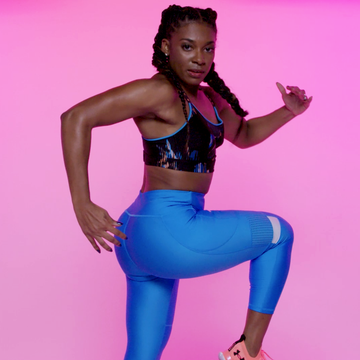So... we were going to kick off this article by reminding you (as we often do in a nifty little parenthetical) that HIIT stands for high-intensity interval training. But in 2017, that sort of feels as unnecessary as explaining that OMG is an acronym for Oh My God. HIIT is now a part of our national lexicon, the bedrock of our fitness routines. See Exhibit A: our dear WH readers. In a recent Twitter poll, 55 percent of you said you love HIIT and do it often.
Keep that up! Science has proven (time and time again) that shifting between periods of fierce activity and active rest within the same workout stokes your fat burners, increasing your metabolism for up to 24 hours post-workout—fondly known as the afterburn effect. On paper, it's genius. In practice? Well, that's where things get complicated.
"All the research shows that the fat-melting magic of HIIT comes from the sharp up-and-down spikes in your heart rate, but most of us don't give ourselves enough time to properly recover between work intervals because we think harder must be better," says certified strength and conditioning specialist Robert Dos Remedios. "The reality is, when you don't rest long enough, those spikes become more like soft waves, which reduces the effect of the workout."
That doesn't just dull the metabolic afterburn effect. Tired begets sloppy—and sloppy begets injury. "The same way you're more likely to make an error on, say, a work report when you're running on empty, your body is more likely to slack on form when it's tanked," says David Freeman, national program manager for the Alpha Training program at Life Time Fitness. "And improper technique is the root cause of most HIIT-induced traumas."
So we asked Freeman to create a better, safer—more effective—HIIT-style plan. Rather than doing the greatest amount of work possible, you'll focus on doing the best work possible. This three-days-a-week routine is designed to boost mobility for everyday movement, blast all your major muscle groups, and zap fat in tricky spots like your abs in as little as two weeks.
Here's how it works: You'll start each session with a quick preactivation warm-up (which studies show helps you get more out of your subsequent workout). That's followed by either the Strength Series or Metabolic Conditioning circuit. Ideally, you want to complete two Strength Series and one Metabolic Conditioning workout each week, on nonconsecutive days, to ensure you don't risk overtraining. (For example, you might do Strength on Monday and Friday, and Met Con on Wednesday.) You'll see that every recovery interval is appropriately matched to the amount of work you'll be doing, and each exercise keeps things simple (you won't find any Olympic lifts or wacky plyos here). In a nutshell, this workout looks good on paper and—gratuitous acronym coming up!—IRL.
To wake the muscles you'll be training, begin each workout with this three-part intro. Starting with the first exercise, perform the number of reps as indicated, then move on to the next exercise without resting (these are low intensity, so you shouldn't need to). Repeat twice for three total sets.
RELATED: This Is the Best Exercise to Erase Your Belly Pooch, Says Science
DYNAMIC SQUAT
Stand with your feet shoulder-width apart, arms at your sides (a). Extend your arms at shoulder height in front of you, then, keeping your torso tall, push your hips back and bend your knees to lower your body as far as you can (b). Pause, then slowly push yourself back up to start. That's one rep; do 20.
STANDING BAND ROW
Stand with feet shoulder-width apart on top of a resistance band and grasp each end of the band, palms facing each other. Bend your knees and hinge forward at your waist (a). With a flat back, lift the band up toward your sides, keeping your elbows close to your body (b). Lower to return to start. That's one rep; do 20.
Here are more resistance band moves you can do to sculpt your arms and abs:
ROPELESS JUMP ROPE
Stand with feet a few inches apart, knees soft, your arms at your sides and palms turned slightly up (as if you were holding a jump rope). Bend your elbows to make small circles with your arms as you jump into the air with both feet. Jump as soon as you land, and continue jumping for 45 seconds.
Functional (read: everyday) movements set you up for long-term strength—and a tight bod. Treat the first two exercises here as a superset: Perform the first move, rest for 45 seconds, complete the second exercise, then repeat the pattern for four sets. Finish with the final exercise for a four-minute on-off bout.
Related: 7 Simple Exercises That Show Results After One Workout
GOBLET SQUAT
Stand with your feet hip-width apart and hold a kettlebell in front of your chest, elbows pointing toward the floor (a). Slowly push your hips back and bend your knees to lower your body as far as you can, elbows brushing the insides of your knees (b). Quickly push yourself back up to start. That's one rep; do 10 to 12, focusing on slow movement on the way down and a quick return to standing.
SINGLE-ARM DUMBBELL ROW
Stand with a dumbbell in your right hand, left hand on your hip, your feet a few inches apart. Hinge forward at your hips so your arm is extended toward the floor and the weight is in front of your right knee (a). With a flat back, brace your abs as you pull the weight up toward your right side, keeping your elbow close to your body (b). That's one rep; do eight to 10, then switch sides.
BICYCLE CRUNCH
Lie flat on the floor with your hands behind your ears (a). Raise your legs, head, shoulders, and back off the floor, then use your abs to drive your left elbow toward your right knee, keeping your left leg straight (b). Release, then drive your right elbow toward your left knee, keeping your right leg straight (c). Continue alternating as fast as you can for 20 seconds, then rest for 10. Repeat for four minutes.
Related: 8 Photos That Prove Lifting Heavy Doesn't Make You 'Bulky'
Let's take things up a notch, working your heart rate and major muscle groups to their max. Start a stopwatch, then perform this trio as quickly as you can, in order, while maintaining proper form for each rep (that's the key goal here). Note your time, rest for two minutes, then repeat the circuit four more times. Aim for a similar finishing time each round.
DUMBBELL THRUSTER
Stand with feet shoulder-width apart and hold a pair of dumbbells at your shoulders (a). Push your hips back and down to lower into a squat (b). Push back up, pressing the dumbbells up until your arms are straight (c). Lower the weights to return to start. That's one rep; do 15.
Related: This 20-Minute Tabata Workout Beats an Hour on the Treadmill
BOX STEP-UP
Stand in front of a step or bench, hands on your hips, and place your left foot on the step (a). Press through your left foot to raise your body until your left leg is straight (b). Bend your left knee and lower your right foot to return to start. Repeat on the other side. That's one rep; do 10.
SPRAWL
Stand with feet hip-width apart (a). Squat down so that your toes and hands are on the floor (b), then quickly kick your legs back to pushup position (c). Your hips should drop close to the floor. Quickly thrust yourself back up to start. That's one rep; do eight.
This article originally appeared in the May 2017 issue of Women's Health. For more great fitness advice, pick up a copy of the issue on newsstands now!

